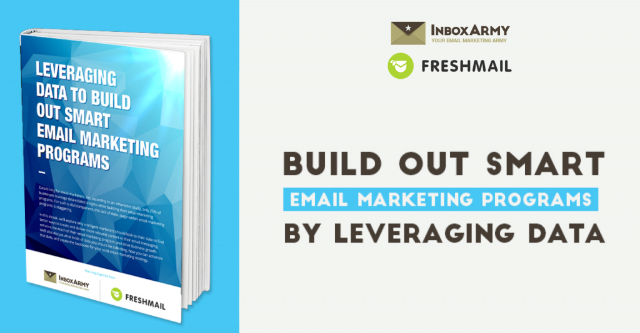 Eliza Gniadek
created
edited
Eliza Gniadek
created
edited
Lead scoring – when is “lead” ready to become a “customer”?
Back to list of articlesYou already know all about the sales funnel. Your mission as a marketer is to move interested consumers through that path to not only turn them into customers, but even further into ambassadors for your brand.
How can you measure their progress along this path? This is where lead scoring comes in.
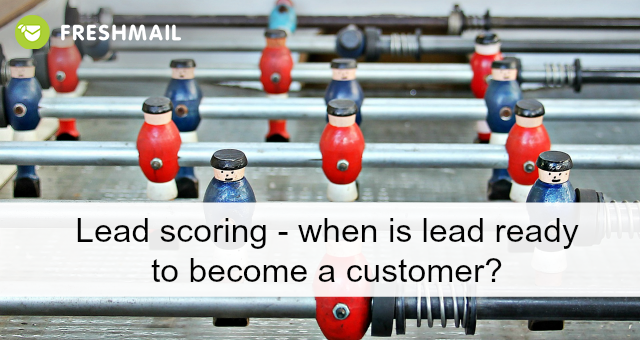
What is Lead Scoring?
Lead scoring is a method of assigning points to addresses in your email list to place them at different points in the sales funnel.
The process allows you to precisely adapt your marketing communication to:
- Recipients who have only recently seen your offer
- Those potentially interested in your product or service
- Anyone ready to make a purchase
- Loyal customers who may become ambassadors of your brand
Lead scoring helps you see when a subscriber turns into a cold lead, when cold leads turn warm, when warm leads become customers and so on.
It’s important to remember that, for lead scoring to work, you have to modify and adapt your activities to current conditions. There is no one universal method of scoring that you can implement right from the start and leave on autopilot.
Implementing Lead Scoring in email marketing communication
To put lead scoring to work, you need a good email marketing system, a spreadsheet and a bit of time. First, though, you have to know what your sales funnel looks like.
Sales funnel
Depending on the field where you operate, the situation may look differently and contain different numbers of elements although they most often include five or six stages.

The stages may be named differently depending on the specifics unique to your product. For our purposes, let’s use this list: subscribers, cold leads, warm leads, customers, returning customers and brand ambassadors.
See how easy it is to create subgroups among everyone in your subscriber list? In this post, we’re going to look at the stages of introducing lead scoring into your email marketing.
Stage 1 - customise content for different groups of subscribers
Take a look at the content on your page - what do you offer subscribers? Blog posts, guides, videos, webinars, ebooks, podcasts - they can all be directed at different groups of subscribers depending on their engagement and level of knowledge.
Now assign each kind of content to one of the groups in your sales funnel. Arrange them on a spreadsheet like this:
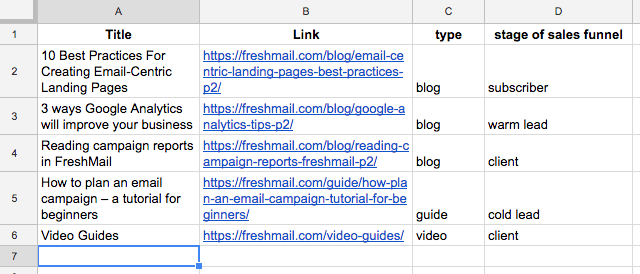
This allows you to clearly see what kind and how much content you have for different groups of subscribers and where you can or should supply more for a particular group.
This is part of the foundation of organising your efforts and helps to ensure that you are providing the right content to the right subscribers according to their position in the sales funnel.
This way you will know what to send in the future and what type of content you should prepare to "push" lead to the next stage in the sales funnel.
Stage 2 - Segment your mailing list
Now let’s look at your newsletters. If you haven’t already, you have to start segmenting your subscribers list. In most cases, it doesn’t matter how big your mailing list is. You can simply create segments that correspond to particular stages in the sales funnel.
There are two main ways to get this done.
The 3-2-1 Method
First, separate customers and returning customers from everyone else. Use information you have from your CRM or other sources to help.
Put together email campaigns for warm leads, those in the 3rd stage in the sales funnel and most likely ready to become a customer.
Subscribers who have opened and clicked on a link qualify as “warm leads”.
Everyone else goes into the group with cold leads and subscribers.
Send a campaign to this group with the content for “cold leads”. The content would focuses on educating them on the virtues of your product and establishing a place for yourself in their purchasing plans. Just like when cold leads become warm, subscribers become "cold leads" when they click on a link in these campaigns.
Everyone else - those who haven’t opened or clicked on anything - remain subscribers, still on the beginning of the sales funnel.
Remember that this method only measures the reactions of those who have opened your messages. That’s why it’s important to focus on optimising both your message subject and sender name. The higher your Open Rate, the better the chances you’ll get the results you want.
This is a straightforward method but it still open to some statistical errors since a large part of your database may not open a given campaign. For better results, send multiple campaigns to addresses in different parts of the sales funnel.
Keep an eye on addresses that remain unresponsive to your campaigns. It’s worth considering switching strategies and sending reactivation campaigns to them instead. Learn more here.
Link tagging
There is a more exact, if time-consuming, method of measuring leads. It lets you see exactly who clicked on a given link and allows you to easily create new segments.
Just as in the 3-2-1 Method, start by segmenting customers and returning customers from everyone else using data from your CRM or accounting.
The first step is the export all the links you’ve sent in your campaigns over, for example, the previous year. This may be take a while if you’ve been especially active in your email marketing, because you have to download data from each report separately.
Put everything in one place by placing all the links on the same spreadsheet.
When you have all the links, add a tag that defines which stage of sales funnel it’s for. This is a good opportunity to evaluate the content that created at the beginning, in stage one.
In your spreadsheet, add a new column that describes your tags. Here’s an example:

This modified list of links then gets imported back into the email marketing system. Thanks to segmentation, you will be able to automatically create segments according to the different levels of the sales funnel.
Remember to tag all of your new links going forward. This will enable you to know immediately when leads advance from one stage to the next.
Tags can be adapted in the fifth stage of the campaign creation process by selecting Enable Advanced and then Link tagging.

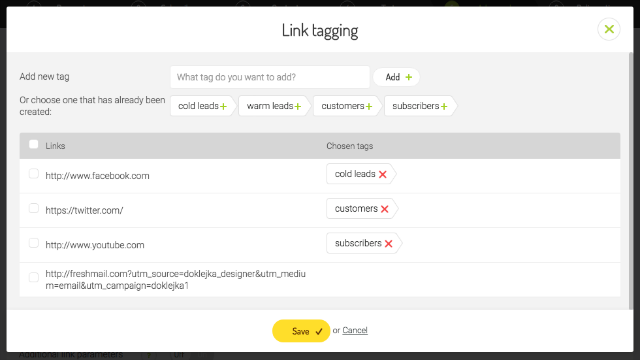
Learn more about tags here: Adding tags in FreshMail
When do leads advance to the next step of the sales funnel?
So far, we’ve covered:
- How many addresses you have at different stages of the sales funnel
- What kind of content to send to each group
To best address the needs of potential customers at different points in the sales funnel, you have to adapt your content to each segment. This doesn’t mean you have to send, for example, five different campaigns. Instead, use dynamic content that automatically adapts and presents the appropriate content for each segment in your database. Learn more about dynamic content in our guide.
So now you create different campaigns for “subscribers”, different for “cold leads”, different to “warm leads” and so on…
So why isn’t it working?!
There is a balance to strike when sending content to subscribers who are on different points in the journey to conversion. In addition to sending them content appropriate for what kind of lead they are, you should sometimes include something that will help to push them to the next level. Just an extra section in your newsletter aimed primarily at the next highest group could be enough to do the trick.
Example: Let’s say you send general introductory content to “subscribers” (those in the first stage of the sales funnel). But the last news is dedicated to “cold leads” and contain more advanced product functionalities or options. If a “subscriber” clicks on a link to such information, it’s a signal that he’s ready to go the next level of the sales funnel.
This strategy can apply to each stage of the sales funnel.
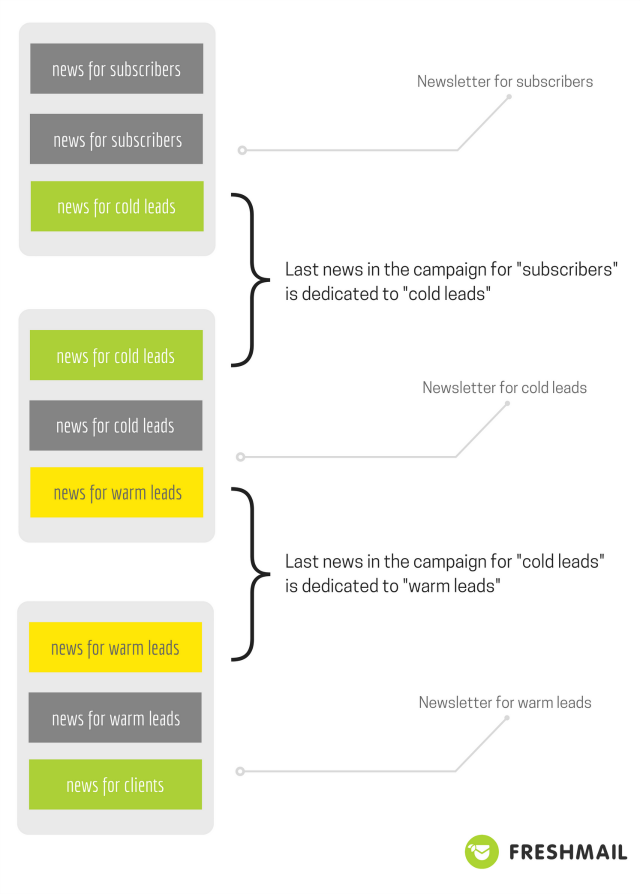
This is a convenient mechanism for guiding prospects to the next stage and, hopefully, all the way to conversion.
But a marketer’s work is never done and further lead nurturing should always be supplemented with more encouragement to make a purchase. This expands the tools you have at your disposal, from dynamic content to autoresponders.
Through integrating your email marketing platform with your CRM and Google Analytics, you can collect a range of information about the purchase histories of your subscribers. Use this knowledge to offer complementary products to match past purchases.
Turning a returning customer into a brand ambassador means creating a partner relationship with them. This often means setting up things like dedicated VIP programs or other reasons for these loyal customers to spread the word about their love for you and your product.
Summary - is Lead Scoring worth it?
The answer is simple - of course it is! If you use the simplest methods and base your segmentation of general differences, adapting your content to speak to different groups will always get results.
Want to know more? Take a look at these posts:


